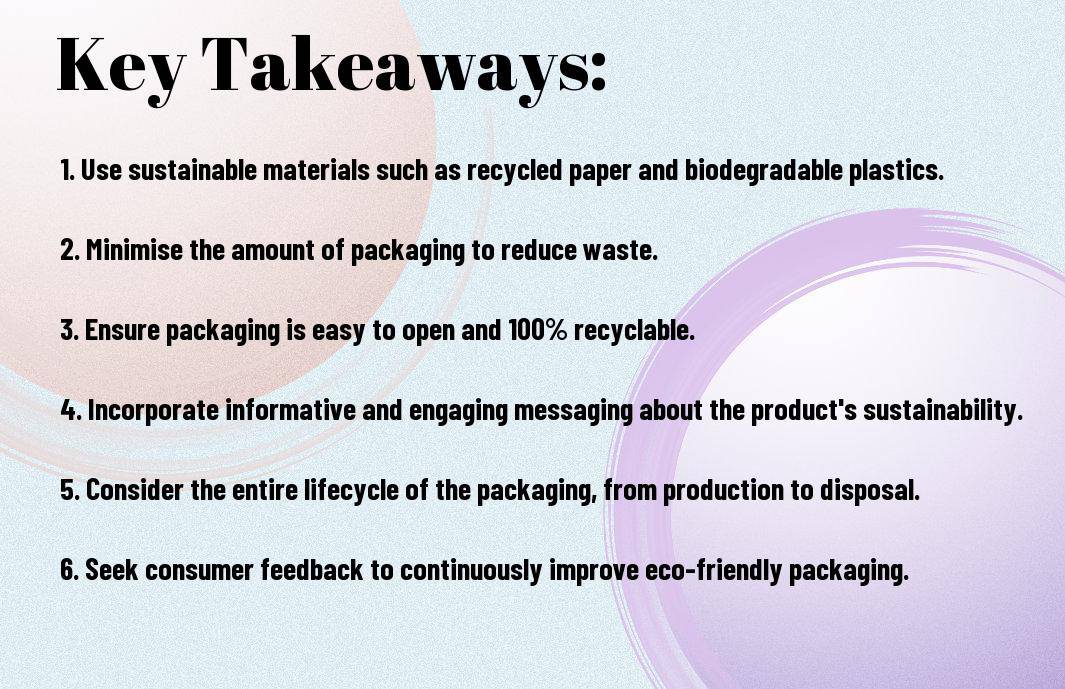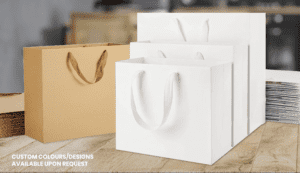Are you looking to create packaging that is not only eco-friendly but also delivers a memorable consumer experience? In today’s environmentally conscious world, it is crucial to consider the sustainability of your packaging choices. To help you achieve this, we have compiled a comprehensive guide to The Switch to Sustainable Packaging: A Guide for Your … that covers everything from materials and design to innovative strategies for enhancing consumer engagement. By implementing the best practices outlined in this guide, you can take the necessary steps towards creating packaging that not only reduces environmental impact but also leaves a lasting impression on your customers.
Key Takeaways:
- Consider sustainable materials: It is crucial to choose renewable, biodegradable, and recyclable materials for packaging to reduce the environmental impact. Materials such as cardboard, paper, and bioplastics can be excellent choices for eco-friendly packaging.
- Optimise packaging design: Design packaging that uses minimal materials while still providing adequate protection for the product. Additionally, consider designing packaging that can be reused or repurposed by the consumer, enhancing the overall consumer experience and reducing waste.
- Communicate sustainability: Clearly communicate the eco-friendly features of the packaging to consumers, as well as any instructions for proper disposal or recycling. This transparency can help build trust with environmentally-conscious consumers and further enhance the consumer experience.

Key Factors to Consider in Designing Eco-Friendly Packaging
When it comes to designing eco-friendly packaging that also enhances the consumer experience, there are several key factors that you need to consider. By taking these factors into account, you can create packaging solutions that not only reduce environmental impact, but also meet consumer expectations and preferences.
- Understanding the Principles of Sustainability
- Meeting Consumer Expectations and Preferences
- Minimising Environmental Impact
- Maximising Product Protection
- Utilising Sustainable Materials
Recognizing these factors and incorporating them into your packaging design process is crucial in creating packaging solutions that are both sustainable and consumer-friendly.
Understanding the Principles of Sustainability
When designing eco-friendly packaging, it is essential to have a solid understanding of the principles of sustainability. This involves considering the entire lifecycle of the packaging, from material sourcing and production to end-of-life disposal. You should strive to design packaging that is not only made from sustainable materials, but is also recyclable or biodegradable, and minimises waste and energy consumption throughout its lifecycle.
Meeting Consumer Expectations and Preferences
Another crucial factor in designing successful eco-friendly packaging is meeting consumer expectations and preferences. Consumers are becoming increasingly conscious of the environmental impact of product packaging, and they expect brands to provide sustainable packaging solutions. It’s important to consider consumer preferences for packaging that is convenient, easy to use, and visually appealing, while still being environmentally friendly.
Best Practices in Eco-Friendly Packaging Design
When it comes to designing eco-friendly packaging that also enhances the consumer experience, there are several best practices that you should consider. These practices aim to reduce the environmental impact of packaging while still meeting the needs and expectations of consumers. By adopting these best practices, you can create packaging that not only appeals to environmentally conscious consumers but also adds value to the overall product experience.
Utilizing Sustainable Materials
Choosing sustainable materials for your packaging is crucial in reducing its environmental impact. Consider using materials such as recycled paper, cardboard, or bio-based plastics for your packaging. These materials can be sourced responsibly and are often biodegradable or recyclable, minimising the amount of waste that ends up in landfills. By opting for sustainable materials, you can significantly reduce the carbon footprint of your packaging and demonstrate your commitment to environmental stewardship.
Optimizing Packaging Design for Durability and Reusability
Designing packaging with durability and reusability in mind can significantly enhance the consumer experience while also promoting sustainability. Durable packaging not only protects the product during transportation but also ensures that it can be reused multiple times, reducing the need for single-use packaging. By implementing a design that can be repurposed or reused, you can provide your consumers with a practical and sustainable packaging solution. This not only adds value to the product but also reduces the amount of packaging waste that ends up in our environment.
The Influence of Eco-Friendly Packaging on Consumer Experience
When it comes to designing eco-friendly packaging that enhances the consumer experience, there are several factors to consider. Not only does eco-friendly packaging benefit the environment, but it also has a significant impact on consumer perception and decision-making. You can learn more about how to create eco-friendly packaging and labeling to ensure a positive impact on both the environment and the consumer experience.
Impact of Packaging Design on Brand Perception
The design of your packaging plays a critical role in shaping how consumers perceive your brand. Eco-friendly packaging not only demonstrates your commitment to sustainability, but it also conveys a sense of responsibility and ethical consciousness. By using sustainable materials and incorporating eco-friendly design elements, you can strengthen your brand’s image and appeal to environmentally conscious consumers. This positive perception can set you apart from competitors and build trust with your target audience, ultimately leading to increased brand loyalty.
The Role of Packaging in Consumer Decision Making
It’s essential to recognise that packaging is a key influencer in consumer decision making. When faced with numerous options, consumers are naturally drawn to products with attractive and environmentally responsible packaging. By leveraging eco-friendly packaging, you can capture the attention of environmentally conscious consumers, demonstrating your dedication to sustainability and ethical practices. This emotional connection can greatly influence purchasing decisions and drive consumer preference for your products over less eco-friendly alternatives.
Case Studies of Successful Eco-Friendly Packaging Enhancing Consumer Experience
When it comes to creating eco-friendly packaging that also enhances the consumer experience, there are several successful case studies that showcase the effectiveness of this approach. Here are some examples of brands that have excelled in this area:
- 1. Lush – Lush Cosmetics is known for their environmentally friendly approach to packaging. They use minimal packaging and opt for materials like recycled paper and biodegradable packing peanuts. This aligns with their values as a sustainable and ethical brand, enhancing their consumers’ experience by offering them a guilt-free purchase.
- 2. Innocent Drinks – Innocent’s commitment to sustainability is reflected in their eco-friendly packaging. They use 100% recycled plastic bottles and have a clear recycling message on their packaging. This resonates with environmentally conscious consumers, enhancing their brand experience.
- 3. Patagonia – Patagonia’s eco-friendly packaging not only reflects their commitment to the environment but also adds value to the customer experience. With their innovative packaging design, they provide useful information on recycling and reusing their packaging, empowering their consumers to make sustainable choices.
Analysis of Successful Eco-Friendly Packaging Designs
Successful eco-friendly packaging designs not only contribute to environmental sustainability but also enhance the overall consumer experience. By using sustainable materials and reducing excess packaging, brands like Lush, Innocent Drinks, and Patagonia have created packaging that aligns with their consumers’ values, making them feel good about their purchase and strengthening their brand loyalty.
Lessons Learned from Eco-Friendly Packaging Failures
While eco-friendly packaging can offer numerous benefits, there are also lessons to be learned from failures in this area. Some companies have faced challenges with eco-friendly packaging, such as compromising product protection, increasing costs, or failing to effectively communicate their sustainability efforts. It is essential to carefully consider all aspects of eco-friendly packaging design to avoid potential pitfalls and maintain a positive consumer experience.
Future Trends in Eco-Friendly Packaging and Consumer Experience
As you look to the future, it is essential to consider the evolving trends in eco-friendly packaging and how they will impact the consumer experience. From sustainable materials to technological innovations, the landscape of packaging design is constantly changing. Understanding these future trends will allow you to stay ahead of the curve and continue to meet the needs and preferences of your environmentally-conscious consumer base.
The Evolution of Consumer Expectations
The demand for eco-friendly packaging is only expected to grow as consumers become increasingly aware of the environmental impact of traditional packaging materials. As a result, you can expect consumers to gravitate towards brands that prioritise sustainability in their packaging. This means that not only will they be looking for packaging that can be easily recycled or composted, but they will also be drawn to brands that demonstrate a commitment to reducing their overall environmental footprint. This shift in consumer expectations presents an opportunity for you to not only meet the demand for eco-friendly packaging but to also position your brand as a leader in sustainable practices.
Innovations that Can Further Enhance the Consumer Experience
Innovative technologies such as augmented reality and smart packaging are poised to revolutionise the way consumers interact with products and their packaging. Augmented reality can be used to provide consumers with a virtual experience that educates them about the sustainability of the packaging and the product within. Smart packaging, on the other hand, can offer consumers real-time information about the environmental impact of the packaging, allowing them to make more informed purchasing decisions. By embracing these innovations, you can not only enhance the consumer experience but also provide valuable transparency about your sustainability efforts, ultimately strengthening your brand’s reputation.
Conclusion: Best Practices for Designing Eco-Friendly Packaging
Hence, when designing eco-friendly packaging that also enhances the consumer experience, it is important to consider materials that are sustainable and easily recyclable. Incorporating innovative and functional designs that make the packaging reusable or biodegradable can greatly reduce its environmental impact. Furthermore, focusing on creating a visually appealing and informative packaging design can also enhance the consumer experience, making it both attractive and practical. By implementing these best practices, you can create packaging that not only benefits the environment but also increases consumer satisfaction.
FAQ
Q: What are the key considerations for designing eco-friendly packaging?
A: When designing eco-friendly packaging, it is important to consider using sustainable materials, minimizing the use of unnecessary packaging, and ensuring the packaging is easily recyclable or biodegradable. Additionally, reducing the carbon footprint in the production and transportation of the packaging is essential.
Q: How can eco-friendly packaging enhance the consumer experience?
A: Eco-friendly packaging can enhance the consumer experience by showing the brand’s commitment to sustainability, which can resonate positively with environmentally conscious consumers. It can also provide practical benefits such as ease of use and convenient disposal, which can improve customer satisfaction.
Q: What are some sustainable materials commonly used in eco-friendly packaging?
A: Common sustainable materials used in eco-friendly packaging include recycled cardboard, biodegradable plastics, compostable materials such as cornstarch, and natural fibres such as hemp or bamboo. These materials help reduce the environmental impact of packaging and promote a circular economy.
Q: How can packaging design contribute to reducing environmental impact?
A: Packaging design can contribute to reducing environmental impact by optimizing the use of materials, minimizing waste, and ensuring efficient use of space to reduce transportation emissions. Additionally, incorporating design elements that encourage recycling or reuse can further support sustainable practices.
Q: What are the regulatory considerations when designing eco-friendly packaging?
A: When designing eco-friendly packaging, it is important to comply with relevant environmental regulations and standards, such as those governing recyclability and compostability. Understanding and adhering to these regulations is essential to ensure that the packaging meets environmental requirements and is legally compliant.



